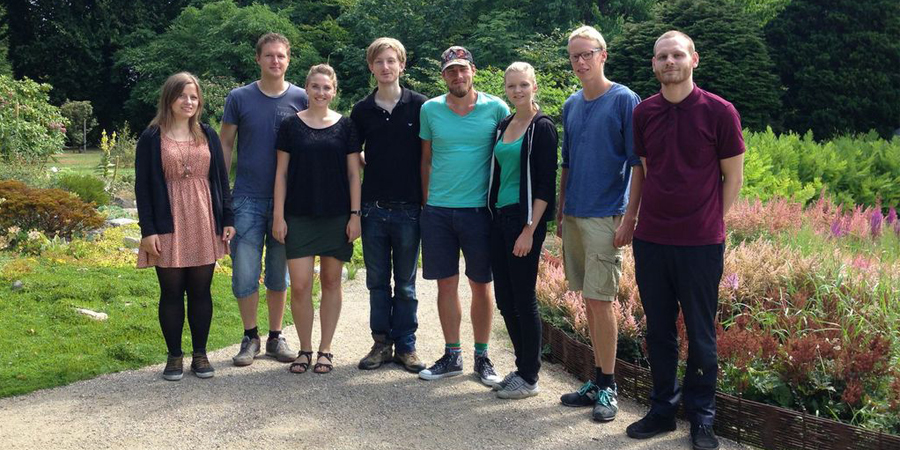Team:UNIK Copenhagen/Signe page
From 2013.igem.org
| Line 170: | Line 170: | ||
</p> | </p> | ||
| - | < | + | <h2>What’s synthetic biology?</h2> |
<p> | <p> | ||
In synthetic biology biomedicine, chemistry, biophysics, nanosciences and genetic engineering combine together. The final aim is to create new biological systems or re-design existing systems to build new non existing functions. In order to achieve this, synthetic biology follows rational engineering processes based on highly characterized genetic parts, the so-called BioBricks. The resulting new devices display functions which lead the way to breakthrough innovations that both have positive effect on our everyday life and push further ahead the boundaries of our scientific knowledge about the complexity of life. | In synthetic biology biomedicine, chemistry, biophysics, nanosciences and genetic engineering combine together. The final aim is to create new biological systems or re-design existing systems to build new non existing functions. In order to achieve this, synthetic biology follows rational engineering processes based on highly characterized genetic parts, the so-called BioBricks. The resulting new devices display functions which lead the way to breakthrough innovations that both have positive effect on our everyday life and push further ahead the boundaries of our scientific knowledge about the complexity of life. | ||
</p> | </p> | ||
| - | < | + | <h2>What’s iGEM?</h2> |
<p> | <p> | ||
The International Genetically Engineered Machine (iGEM) is an annual competition in synthetic biology organized by MIT. The competition is open to motivated undergraduate students who want to work in a team and develop a project of their own exclusive design. The teams are provided with a kit of biological parts from the Registry of Standard Biological Parts (link to the page) to create new functional biological devices in living cells. In turn, new parts built by each team can be submitted to the Registry (link). The project is developed mainly over the summer break and will culminate with the presentation of team results at the Regional Jamboree(link). A few lucky and talented teams will go onto the World Championship Jamboree. This experience is extremely stimulating for the students that have the chance to improve their skills and knowledge working on different aspects of the project as well as making new friends. | The International Genetically Engineered Machine (iGEM) is an annual competition in synthetic biology organized by MIT. The competition is open to motivated undergraduate students who want to work in a team and develop a project of their own exclusive design. The teams are provided with a kit of biological parts from the Registry of Standard Biological Parts (link to the page) to create new functional biological devices in living cells. In turn, new parts built by each team can be submitted to the Registry (link). The project is developed mainly over the summer break and will culminate with the presentation of team results at the Regional Jamboree(link). A few lucky and talented teams will go onto the World Championship Jamboree. This experience is extremely stimulating for the students that have the chance to improve their skills and knowledge working on different aspects of the project as well as making new friends. | ||
Revision as of 10:33, 11 August 2013
-

-
Write a headline here
Write even more stuff here and put < > buttons in both sides

-
Write a headline here
Write more stuff here and make an automatic cycle of slides

Welcome to the Wiki page of the 2013 Copenhagen iGEM Team!
Have you ever wondered if there was a better way to target cancer cells? Find a sustainable alternative to batteries? Or visualize hidden forces in the world around us? We worked on creating such a biological platform using organelles consisting of tiny magnetic crystals housed inside a lipid membrane, known as magnetosomes. These are naturally found in so-called magnetotactic bacteria that use these organelles to orientate themselves in the earth’s magnetic field. In our project we make a proof of concept fusing a fluorescent protein to the membrane of the magnetosome. Through this we open the way for using magnetosomes in all sorts of exciting new applications, like for example targeted drug delivery, developing biological batteries or creating magnetic paint. You will find more information on our project page.
What’s synthetic biology?
In synthetic biology biomedicine, chemistry, biophysics, nanosciences and genetic engineering combine together. The final aim is to create new biological systems or re-design existing systems to build new non existing functions. In order to achieve this, synthetic biology follows rational engineering processes based on highly characterized genetic parts, the so-called BioBricks. The resulting new devices display functions which lead the way to breakthrough innovations that both have positive effect on our everyday life and push further ahead the boundaries of our scientific knowledge about the complexity of life.
What’s iGEM?
The International Genetically Engineered Machine (iGEM) is an annual competition in synthetic biology organized by MIT. The competition is open to motivated undergraduate students who want to work in a team and develop a project of their own exclusive design. The teams are provided with a kit of biological parts from the Registry of Standard Biological Parts (link to the page) to create new functional biological devices in living cells. In turn, new parts built by each team can be submitted to the Registry (link). The project is developed mainly over the summer break and will culminate with the presentation of team results at the Regional Jamboree(link). A few lucky and talented teams will go onto the World Championship Jamboree. This experience is extremely stimulating for the students that have the chance to improve their skills and knowledge working on different aspects of the project as well as making new friends.
 "
"